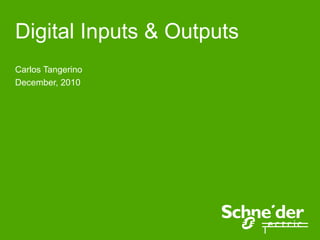Digitalinputsoutputs
- 1. Digital Inputs & Outputs Carlos Tangerino December, 2010
- 2. Schneider Electric 2- Division - Name ŌĆō Date Basic concept ŌŚÅBy default, the outputs are always ON ŌŚÅThe control logic only turn outputs to OFF condition ŌŚÅIf one of the logics decides for turn the output OFF, the final state will be OFF ŌŚÅOne output respect the logics priorities ŌŚÅOne or more outputs respect the priorities among them ŌŚÅLoads with same priority must use round-robin scheduling
- 3. Schneider Electric 3- Division - Name ŌĆō Date Fixed Logic, variable Atributes ŌŚÅThe physical state of a control device (ex.: relay) ŌŚÅ Depends on the physical contacts connections or device model ŌŚÅ ON state means ŌĆō The energy is available for this output ŌŚÅControl atributes ŌŚÅ AUTO ŌĆō Indicated if the state of an output is controlled by the system or by the user. (0=MANUAL, 1=AUTO) ŌŚÅ FORCE ŌĆō If AUTO mode is off, this flag indicates the forced state. (0=Force OFF, 1=Force ON) ŌŚÅ DEMAND ŌĆō Output state from the demand control logic. (0=OFF, 1=ON) ŌŚÅ TIMER ŌĆō Output state from the time control logic (0=OFF, 1=ON) ŌŚÅ TOU ŌĆō Output state from the time of use control logic. (0=OFF, 1=ON) ŌŚÅ INVERTION ŌĆō Command to invert the output state (0=Not Inverted, 1=Inverted)
- 4. Schneider Electric 4- Division - Name ŌĆō Date Control Priorities ŌŚÅOne output may be controlled by more than one internal logic ŌŚÅThe decision for a such state follow the priority list as: ŌŚÅ Lowest priority ŌĆō Demand control ŌĆō Timer control ŌĆō TOU control ŌĆō Bypass ŌŚÅ Highest priority
- 5. Schneider Electric 5- Division - Name ŌĆō Date Control Logic DEMAND TIMER TOU AUTO FORCE INVERTION OUTPUT
- 6. Schneider Electric 6- Division - Name ŌĆō Date Advanced Output DirectDirect TONTON TOFFTOFF Output same as input Timer ON Timer OFF T T We can create many ways to control the output. Worth it? Timers Tempo m├Łnimo OFF Tempo m├Łnimo ON Tempo m├Īximo OFF Pausa ap├│s ON Pausa ap├│s OFF
- 7. Schneider Electric 7- Division - Name ŌĆō Date Control Functions SH SL POFF PON Demand ON OFF Time SH ŌĆō Setpoint High SL ŌĆō Setpoint Low POFF ŌĆō pause after OFF PON ŌĆō Pause after ON Output
- 8. Schneider Electric 8- Division - Name ŌĆō Date Digital Input Physical Interface RAW INPUT DEBOUNCE FILTER DIGITAL INPUT To Application OPEN CLOSE T
- 9. Schneider Electric 9- Division - Name ŌĆō Date Digital Input Type ŌŚÅAlways open ŌĆō Force condition ŌŚÅAlways close ŌĆō Force condition ŌŚÅDirect input ŌĆō Same state as the input ŌŚÅInverted input ŌĆō The state is inverted ŌŚÅCount on close ŌĆō Increment the counter value on close transition ŌŚÅCount on open - Increment the counter value on open transition ŌŚÅCount on change - Increment the counter value on any change ŌŚÅToggle ŌĆō Change state on close ŌŚÅThe input type selection depend on the behavior of the connected device
- 10. Schneider Electric 10- Division - Name ŌĆō Date Digital Inputs - Application ŌŚÅThe digital inputs can be used isolated or in group ŌŚÅOne isolated digital input may be used as: ŌŚÅ Event monitoring ŌŚÅ Alarm monitoring ŌŚÅ KYZ control (TOU, EOI) ŌŚÅOne or more digital inputs may be combined to interface pulse energy meters. Ex: ŌŚÅ Input 1 ŌĆō kWh pulse - received ŌŚÅ Input 2 ŌĆō kVArh pulse - received ŌŚÅ Input 3 ŌĆō kWh pulse ŌĆō delivered ŌŚÅ Input 4 ŌĆō kVArh pulse ŌĆō delivered ŌŚÅ Input 5 ŌĆō EOI pulse ŌŚÅ Input 6 ŌĆō TOU pulse (off-peak) ŌŚÅMixed mode as pulse counter and trip detection at same input










